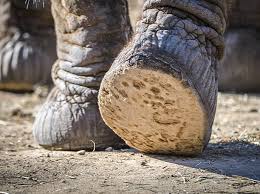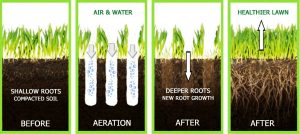Holey Moley – Let’s look at the importance of lawn aeration…
We mostly judge our lawns by the appearance of their leaves. Let’s take a moment to consider the importance of the soil structure in the health of your lawn.
Within the soil, a network of roots not only anchors the plant, but also acts as it’s access to essential nutrients and moisture. Without a healthy, fully functional and well-developed root system your grass plant is never going to thrive.
Mind the gaps
Roots don’t actually grow in soil. Roots grow in the gaps within the soil, working their way deep into the ground through the network of tiny crack between the minerals and organic matter that makes up what we call soil. Soil should comprise of 25% air, 25% water, 45% minerals – that’s what you get when large rocks are broken down over time. Let’s not forget the remaining 5% which is humus. Not the chickpea dip, humus is the organic matter created when animals and plants decompose and it’s the essential food source for life within the soil.
Watch this amazing video of roots growing
Where does soil come from anyway?

aeration relieves compaction from foot traffic
As soil forms from the action of weather on rocks, plants begin to grow in it. These plants mature then die and new ones grow in their place. The leaves and roots of the dead plants are added to the soil. Animals eat plants and other animals. Their waste and, when they die their bodies, are added to the soil. Bacteria, fungi, worms and other creatures break down plant litter and the animal waste or remains and these then become the organic matter which help create healthy soil.
Life’s essentials
All living things need three essentials to survive. Whether you’re an elephant or an earthworm, unless you have water, air and food you’re not going to survive for very long. Restrict any of these three essentials and that living thing is going to suffer and struggle to be healthy. Grass plants are no different and neither are the microbes within the soil, critical to the health of your lawn.
Compaction – it’s a hard life
Now you have a bit of background about what your lawn soil is made up of, let’s talk about the importance of air gaps within your soil. Lawns get a lot of foot traffic. We are out there barbecuing, kicking a ball around or pegging out laundry. Over time this foot traffic compacts the soil beneath your lawn, gradually reducing the air gaps which are essential to life. Less air means fewer insects that break down dead plant material. It also means less microbial activity. This is a major issue. Beneficial microbes create a relationship with the plant roots, making important nutrients available and producing growth hormones that protect the plant from pests, parasites and diseases. Fewer microbes means the balance of nature is upset – don’t upset Mother Nature!

Aerate for better root growth
Feeling gassy
Air gaps within soil are essential for the plant. Without air your grass would die. Plants don’t just breathe through their leaves. For roots to be healthy they too must breathe. Roots take in oxygen through tiny hairs within the gaps in the soil. When roots have limited access to air gaps in soil this gaseous exchange is compromised. Plants will be weakened, making them less vigorous and more susceptible to attack from pests and disease.
Loosen up man
So, what can we do to help nature along and create a healthier environment? The answer is aeration. Aeration is the mechanical introduction of air spaces within soil to provide the essential balance needed to support soil life and healthy roots.
You could do this with a garden fork. Stamp the fork into the ground, rock it back and forth, remove and repeat – over the whole lawn area. Trust me, this is really hard work. Lawn care professionals use petrol-powered aerators specifically designed for the task. It’s still hard work but its far more effective than a garden fork. The aerator is fitted with a metal tine that is driven deep into the ground to create a hole. If a hollow tine is used it pulls out a small plug of soil which is deposited on the surface of the lawn and soon breaks down. The surrounding soil now has the space to ‘relax’ into the hole, creating cracks and gaps within the soil and more air spaces.
These newly created holes also allow dead plant matter into the soil where it can decompose and be broken down by insects and beneficial microbes, creating a heathier soil environment.
Root pruning
Hollow tines cut into the soil and also cut through the roots of the grass plants. As these roots re-grow, they do so in a more fibrous way with a greater surface area. More root area means more access to food, water and air – the essentials for a healthy plant. Aeration is by far the most beneficial mechanical process for any lawn and should ideally happen at least once a year.
Drainage issues
Finally, compaction issues are often responsible for water-logging. When the air gaps become filled with water instead of air they prevent the roots from accessing the essential air needed for life. The lack of air in the soil also impacts the life of beneficial bacteria and promotes the growth of damaging bacteria which reproduce in anaerobic environments, This virtual ‘soil death’ will result in actual grass plant death. Regular aeration relieves compaction which can reduce water-logging.
Follow us on Facebook or check out our website for regular lawn care advice

 Established 2016
Established 2016



